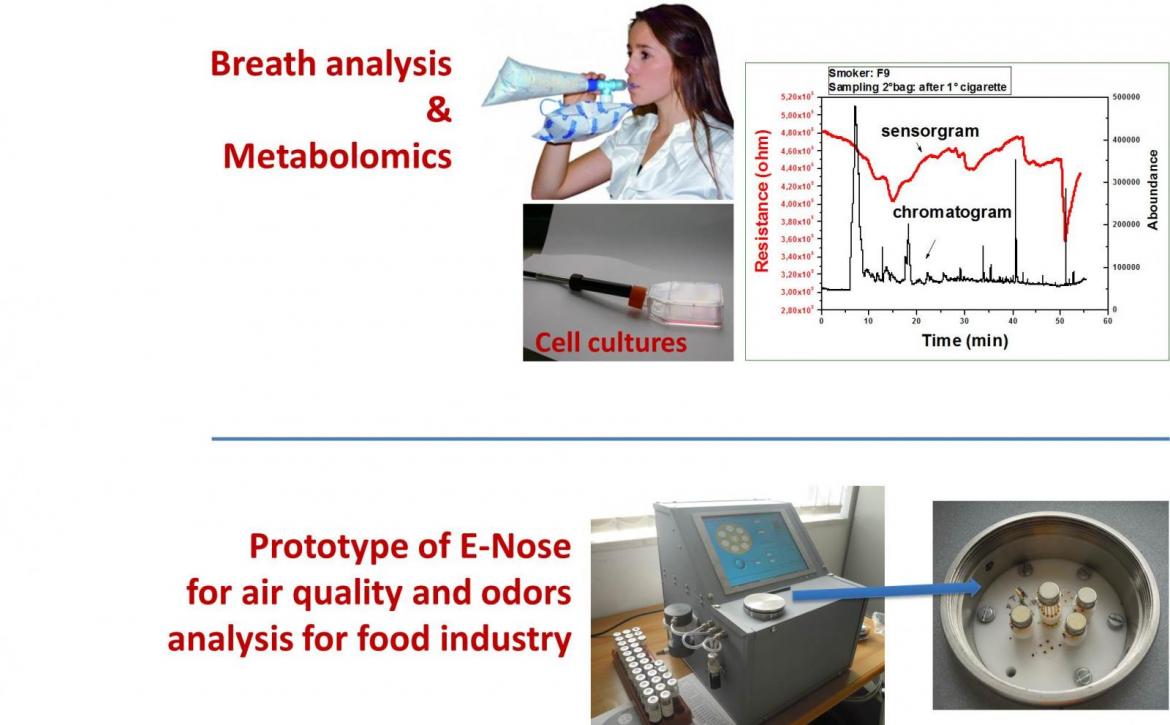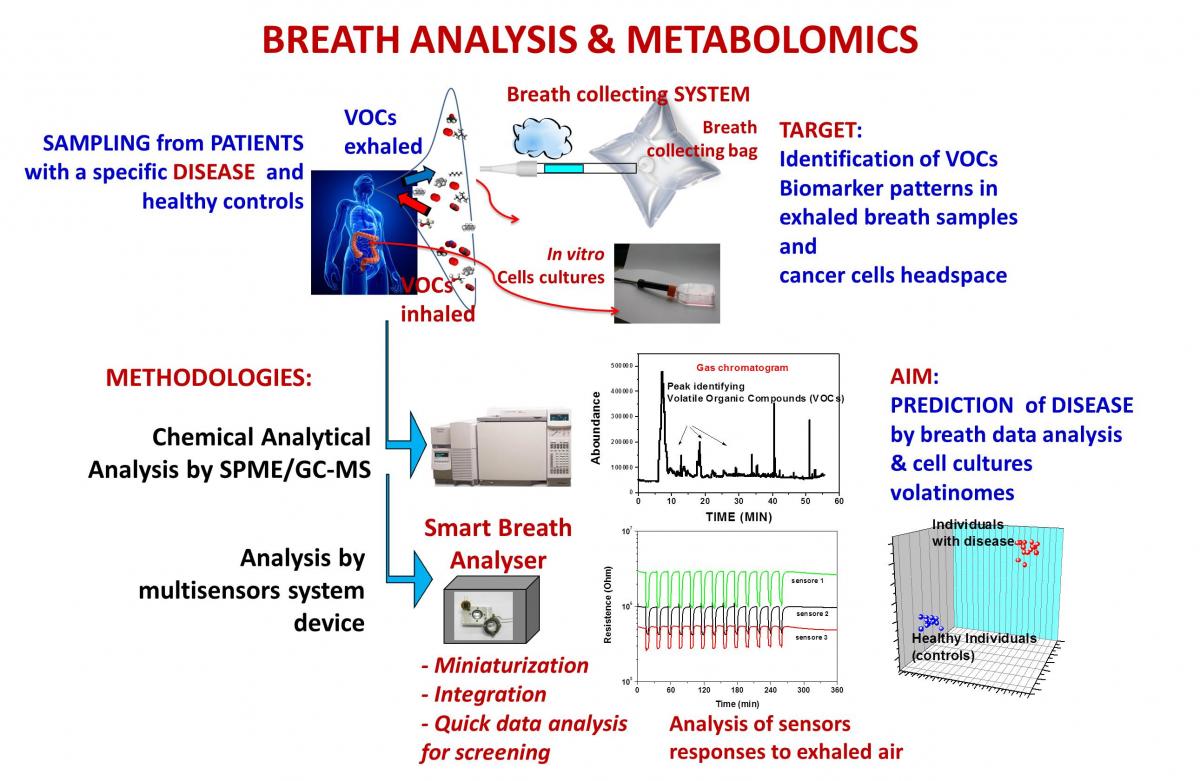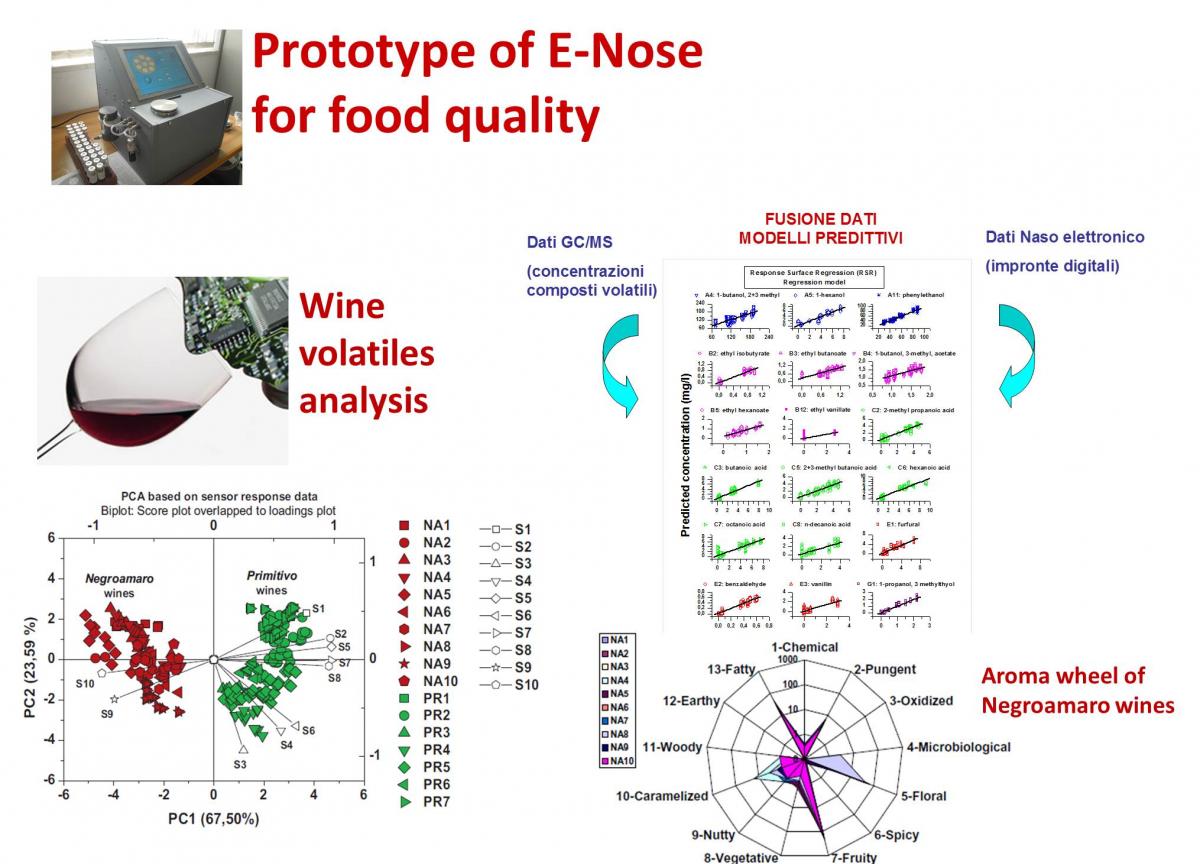
The development of future multifunctional chemical sensing devices requires multidisciplinary integration of different skills (physics, engineers, biologists, chemists, physicians) and technologies (sensing materials, sensors, micro/nanosystems, sampling systems, embedded electronics, analytical chemistry, signal processing, pattern recognition and communication).
At IMM-Lecce unit, the activities of the group working on sensors and multifunctional sensing systems are carefully balanced between basic research and application-driven developments targeting technological transfer. The research is focused on innovative integration solutions of smart components in different multifunctional sensing systems as well as on new analysis methodologies for analytical chemical systems.
The targeted application sectors are:
- aroma monitoring in food safety and quality
- biomarkers detection in breath analysis & metabolomics.
In particular, the main topics are:
- Development of an integrated portable E-nose based on micromachined gas sensors devoted to the headspace analysis of liquid/solid samples for food quality and safety.
- Development of advanced chemical analytical methods by a peculiar configuration of a gas chromatograph (GC) coupled to two detectors: 1) mass spectrometer (MS) and 2) semiconducting gas sensor (SGS), operating in dual mode (GC/[MS+sensor] system). The methods are addressed to the identification of Volatiles Organics Compounds (VOCs) as novel concept of biomarkers in exhaled breath and cell cultures.
- Development of a multifunctional gas sensor system for the analysis of exhaled breath of patients with diseases (e.g. home-assisted patient with chronic respiratory problems, children with asthma, colorectal cancer).
- Advanced Pattern Recognition for the data analysis from multifunctional system & data fusion techniques supported by GC/[MS+sensor] system for calibration.
- Method and system for measuring physiological parameters of a subject undergoing an olfactory stimulation (EventRelated Potential (ERPs) by Electroencelography (EEG) under olfactory stimulation).

At present “Breath Analysis” is attracting a huge scientific interest for its powerful potential in medical diagnostics and for its strength of noninvasiveness. Due to an almost instantaneous equilibrium between pulmonary blood and the air in the lung alveoli, the complex mixture of several hundreds of VOCs in the alveolar volumes, at very low concentration ranges (ppbv up to maximum a few ppmv) represents someway a dynamic fingerprint of healthy status of an individual, just like a “snapshot” of the various biochemical pathways that the volatile compounds follow inside the body. The main medical interest is addressed to identified and measure those exhaled VOCs, that can be proposed as biomarkers for particular diseases and/or metabolic disorders. By the detection of exhaled VOCs biomarkers, the challenge of breath analysis is to become a significant clinical test by which it will be possible to differentiate:
- healthy persons from sick patients suffering a particular pathology for diagnostics purposes, but also
- healthy persons from patients in a clinical risky status, when the pathology is in early stages for prevention.
Breath biomarkers could be measured also during disease progression, or during a pharmacological treatment, or after a surgery intervention, to follow the effect of a therapy.
Moreover, in order to elucidate the metabolic origins and the disease specificity of VOCs identified in the patients’ breath, the VOCs produced by cancerous cells in vitro model have to be analyzed. Cell cultures volatinomes can be used as a bottom-up approach to identify biomarkers of pathological conditions and to get essential information about the tumor biochemistry.
At IMM-Lecce unit we are approaching “Breath analysis & Metabolomics” topic working the design of:
- novel automated breath sampling system in breath collecting bags
- new bioreactors for cells cultures for cells microenvironment analysis
Two different methodologies are used for the application:
- Chemical Analytical Analysis by SPME/GC-MS. The system is equipped with splitter allow the connection to a semiconducting gas sensor use as second detector; this approach looks to a future developing of miniaturized gas chromatographs based on gas sensor detector.
- Analysis by multisensors system device (e-Nose) based on semiconducting gas sensors. The e-Nose approach offers an alternative to complex spectrometry techniques for a quick and easier breath analysis useful for qualitative analysis purposes and disease screening in population.
Prototype of E-Nose for food quality
The research activity is devoted to characterization of multisensor array and the development of instruments known as “Electronic Noses” (E-noses) for a wide range of applications, the main being food quality and safety. Our research group explored the potential use of E-nose in food industry for the analysis of different foodstuff (olive oil, wine, milk, fruit, etc.). E-nose great potential consists in the ability to differentiate samples according to their volatile composition, quickly and objectively for quality control purposes.

Recent results regarded wine aroma volatiles of two different typical Apulian wines made by autochthonous grape varieties (i.e. Negroamaro and Primitivo). We showed that our e-Nose gave an objective analysis of wine aroma providing for each wine a unique response pattern designated as a “digital map” of its odours. Far from being completely substitutive to chemical analysis and to sensory analysis, E-noses are closely linked to them, especially in a preliminary phase of training of the multi-sensors systems, when it is necessary to correlate the sensor response pattern to the chemical pattern of the analyzed wines, i.e. to the chemical composition of the volatile fraction of the wine sample, acquired by GC–MS, or to the sensory evaluations of the panel test.
Contact person: Simonetta Capone


